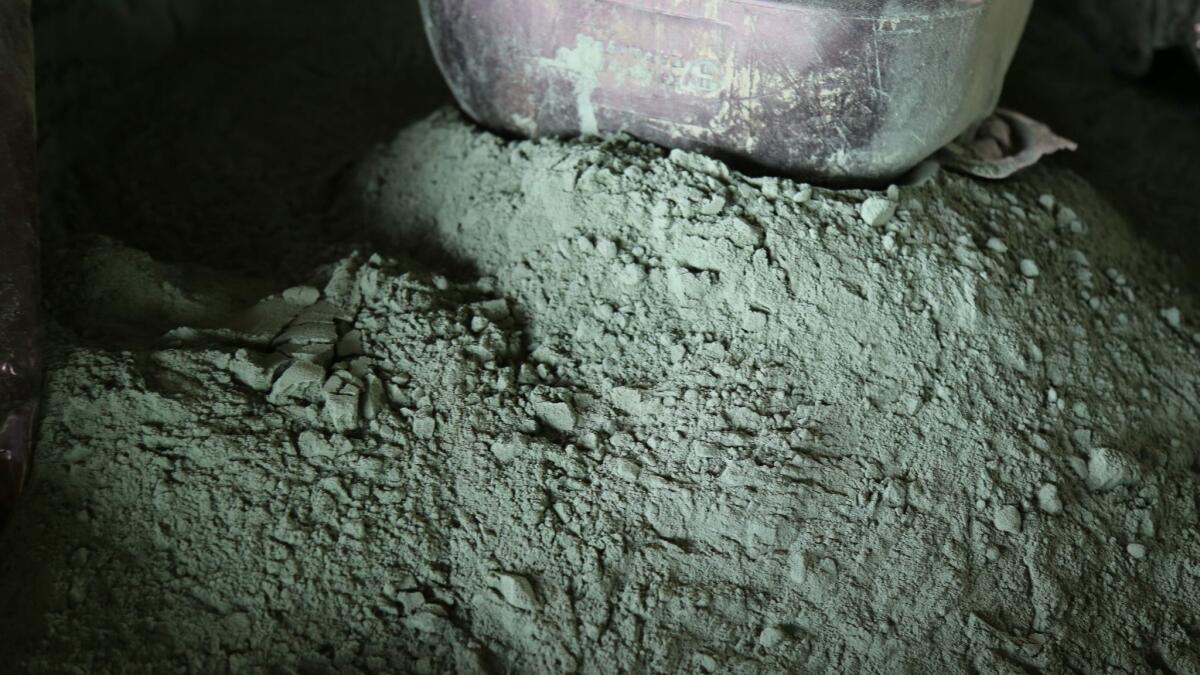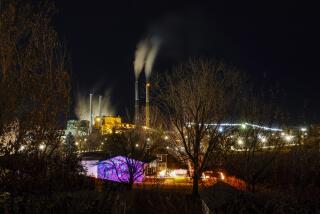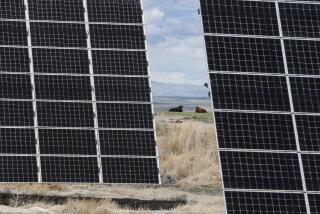Electric vehicles’ future relies on cobalt. It’s often mined by children and is soaring in price

- Share via
The road to an imminent electric vehicle future has hit a speed bump — one made of cobalt.
An essential ingredient in lithium-ion batteries that power millions of smartphones as well as plug-in electric cars, cobalt is in heavy demand.
But just as the silverish-gray metal has established itself as a critical element in the growth of the market in electric vehicles, cobalt has also become a source of serious ethical and economic concerns.
Most notably, the majority of the world’s cobalt production is concentrated in the Democratic Republic of Congo, where in many cases children work in hazardous conditions mining the metal.
And once extracted, there are questions whether enough long-term supplies of cobalt can be established to fulfill the hopes of policymakers in places like California who want to transform the transportation system from gasoline-powered vehicles to EVs.
Supporters think the problems associated with the mining of cobalt can sort themselves out, but even the most ardent acknowledge human rights as well as supply-chain issues need to be resolved.
One company that’s taking matters into its own hands is Apple Inc., which is in talks to buy cobalt directly from mining companies, according to Bloomberg. The contracts would secure several thousand metric tons of cobalt a year, ensuring a steady supply for Apple’s iPhone and iPad batteries. Apple is one of the largest consumers of cobalt; about a quarter of global production of the metal winds up in smartphones.
A direct supply also would give Apple greater control over mining conditions. Amnesty International alleged in 2016 that Apple and Samsung Electronics Co.’s Chinese suppliers were buying cobalt from mines that rely on child labor. Last year, Apple published a list of the companies that supply the cobalt used in its batteries and said it would not let cobalt from small-scale mines in Congo into its supply chain until it could verify that the “appropriate protections” were in place.
The connection between cobalt and clean-car technology may come as a surprise to many car buyers.
“I think it’s really difficult for the average consumer to understand all the science and the rare earth minerals that go into” the production of batteries for EVs, smartphones and computers, said Blaine Townsend, senior vice president at the Foster City, Calif.-based investment firm Bailard Wealth Management.
The cathodes in lithium-ion batteries typically used in EVs are made of metal oxides that contain a combination of cobalt and other elements. Cobalt helps the cathodes concentrate a lot of power in a confined space. Without the element’s energy density, batteries without cobalt tend to perform worse.
It’s harder to recycle electric car batteries than lead-acid batteries used in gasoline-powered vehicles because of the number of materials involved and differences in how manufacturers build them.
As the EV sector attempts to move from niche-market status to mainstream acceptance, cobalt demand is surging.
California policymakers have pushed zero-emissions vehicles as essential to meet the state’s mandates to dramatically reduce greenhouse gas emissions. Gov. Jerry Brown has set a target of 1.5 million clean-energy vehicles on California’s roads by 2025. In his final State of the State address last month, Brown ratcheted the number even higher — to 5 million zero-emission vehicles by 2030.
The United Kingdom and France have announced plans to phase out gasoline and diesel-powered vehicles by 2040. All 16 states in Germany — home of Mercedes-Benz, BMW and Audi — passed a nonbinding resolution to ban the sale of new gasoline and diesel vehicles by 2030.
While no date was set, a government official in China last year announced the country’s intention to ban the sale of cars using fossil fuels. China represents the auto industry’s largest market in the world, even bigger than the U.S.
Automakers are making their own moves.
Tesla has begun rolling out its Model 3, with a stripped-down base price of $35,000, marketed as an EV for the masses. Ford announced plans to spend $11 billion on EVs by 2022. Volvo executives have vowed that by 2019 all its models will be either hybrids or powered solely by batteries.
GM said it will add two more all-electric cars to its fleet later this year and at least 18 more by 2023. “General Motors believes the future is all-electric,” Mark Reuss, the company’s head of product development, said last October.
Those plans are outrunning demand for EVs. Less than 1% of U.S. motorists own an electric vehicle. Consulting firm IHS Markit projects 94 million vehicles will be sold globally this year, with EVs accounting for 4 million, or about 4%.
But a 2017 report from the financial giant Morgan Stanley projected as many as 1 billion electric vehicles could be on the road worldwide by 2050. Anticipating a flood in global sales of EVs, the demand for cobalt used in electric car batteries is expected to increase nearly eight-fold by 2026.
The production of cobalt has quadrupled since 2000, but the price of the metal has skyrocketed, too — up more than 230% since the end of 2015.
The vast majority of cobalt is a byproduct from the mining of nickel and copper; 54% of the world’s supply comes from the Democratic Republic of Congo.
Congo has suffered through two extremely violent civil wars in its relatively short history. The rule of law is haphazard, and institutions are rife with corruption.
Mining is a linchpin of the economy, but the work is often dangerous. Freelancers, known by the French word creuseurs, use picks and shovels to dig up cobalt; child labor is common.

The 2016 report from Amnesty International cited estimates from UNICEF that about 40,000 boys and girls work in mines across Congo, many of them at cobalt sites.
As with adult miners, the children are exposed to high levels of cobalt and work without gloves or masks, the report said.
Tesla has pledged to not take cobalt from child labor or creuseurs. But it’s hard to track the metal’s origination once it has reached the end of the supply chain.
“It could come from 50 small suppliers to a middleman,” Townsend said. “That middleman and five other middlemen ship what they’ve got to a smelter in China, and western companies have to buy from that smelter.”
With an eye on its growing assembly lines of EVs, China has moved quickly to gobble up stocks of cobalt. According to the CRU Group, a mineral consultancy, China controls 62% of the world’s cobalt supply.
That’s left North American and European carmakers scrambling to sign long-term contracts to ensure their own supplies, as Apple is trying to do. It’s also led to searches for cobalt in other places. Canada is the fourth-largest producer of cobalt, and miners in provinces from Ontario to the Northwest Territories are looking at potential sites to develop.
Cobalt production in the U.S. is small — just 650 metric tons in 2017, according to the U.S. Geological Survey. Congo, by comparison, produced 64,000 metric tons.
A number of chemical companies and researchers are working on batteries for EVs that rely less on cobalt. Two South Korean companies plan to roll out batteries that are eight parts nickel and just one part cobalt and one part manganese.
But earlier this month, the chief executive at a Belgium-based multinational that produces cathodes for EV batteries said cobalt will still be needed for the foreseeable future.
“There isn’t a better element than nickel to increase energy density, and there isn’t a better element than cobalt to make the stuff stable,” Marc Grynberg, the chief executive at Umicore, told Reuters. “So [while] you hear about designing out cobalt, this is not going to happen in the next three decades.”
At the same time, Grynberg and others think concerns about cobalt supplies can be eased by finding a more efficient way to recycle smartphones. There are an estimated 1.6 billion discarded phones across the globe with batteries that include cobalt.
Analysis from researchers at MIT have predicted that while there may be some bottlenecks in the supply chain, no serious obstacles are in place for the next 15 years to blunt rising demand.
“I think what will happen is the lithium-ion battery is probably going to be a transitional power source,” said Townsend, “and scientists are going to figure out a different chemical composition to power the electric vehicles that has less risk from the supply-chain standpoint.”
Others are less sanguine.
“Until there’s a replacement material that can hold a charge and create a charge, we’ve got a problem,” said Lauren Fix, executive director of the Car Coach and a New York-based automotive expert who is critical of EVs.
Bloomberg contributed to this report.
Nikolewski writes for the San Diego Union-Tribune.
More to Read
Inside the business of entertainment
The Wide Shot brings you news, analysis and insights on everything from streaming wars to production — and what it all means for the future.
You may occasionally receive promotional content from the Los Angeles Times.










